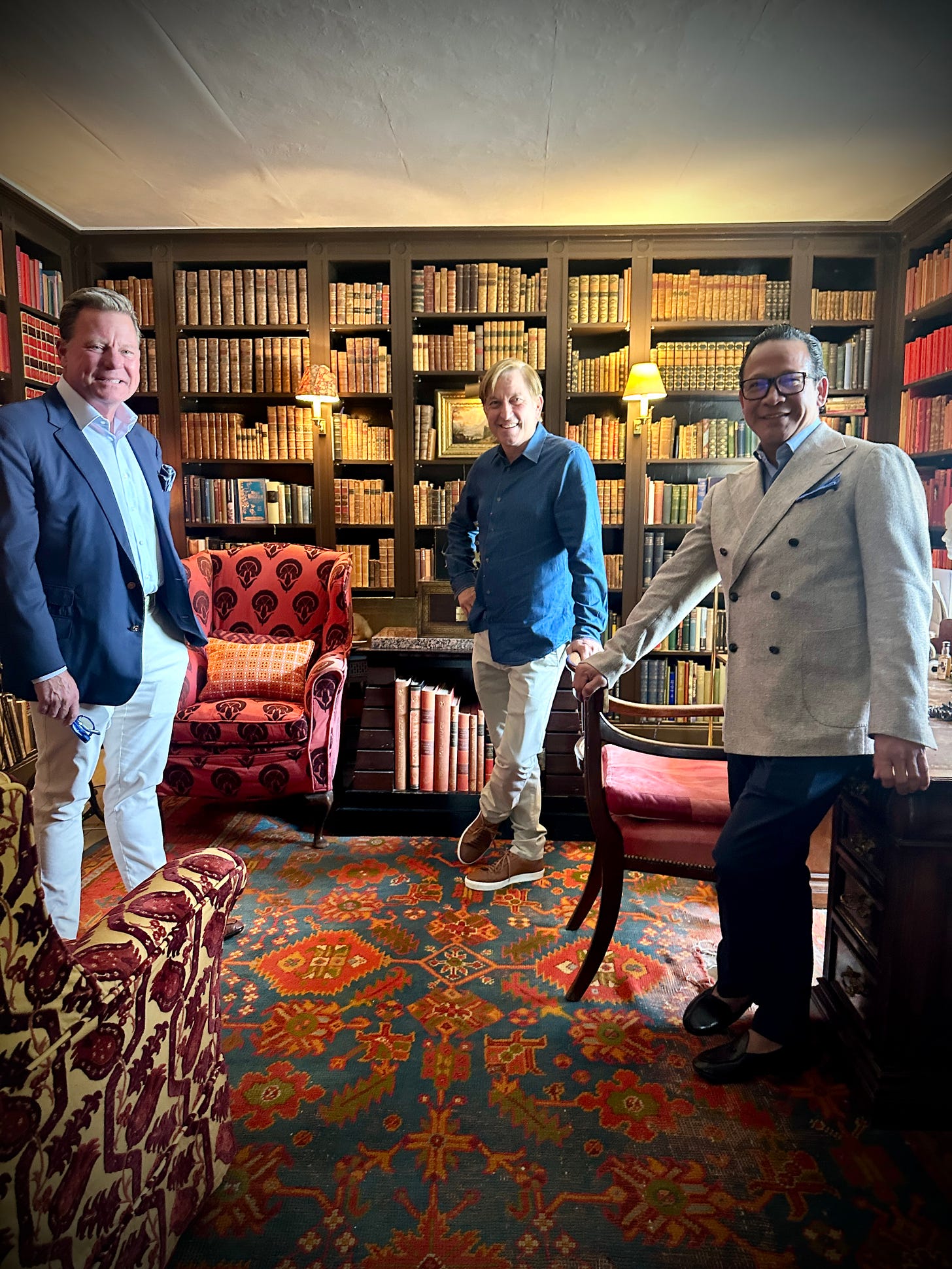Strolling through the garden with Paul Bangay
Paul Bangay, the prominent Australian garden designer, was significantly influenced by the work of my late father, British interior decorator and garden designer, David Hicks.
Paul considered my father a mentor and a major inspiration for his career. He says my father’s influence can be seen throughout his 40 year career, through the use of color palettes, planting designs, and overall garden aesthetics. So it was interesting to stroll around my parents garden with Paul, seeing it through his eyes.
We were also joined by Tim Johnson and his partner Fernando Wong, who is the creative mind behind many of Florida’s lushest landscapes. Whilst having tea and crumpets, before our walk, we all shared a good grumble about garden pests; moles in England, iguanas in Miami and possums in Australia.
My father told a young impressionable Paul back in the early 1980’s, when he first visited the Grove garden, how he loved avenues and vistas; he always professed to being "very much a straight-line gardener."
He always began with the view from a principal room in the house, the dining room, the drawing room, the library (seen above). "For much of the year, living in England, one's main enjoyment will be from the inside," he said, "so the first thing is to get the vista sorted. Then you can embroider in between.”
Nevertheless, his embroidery remained quite monochrome; the local ladies were mystified when they were invited to visit. Where were all the flowers? It wasn't that he disliked flowers, it was just that he preferred not to see them growing.
For his sixtieth birthday, my father gave himself a moated and turreted Gothic garden pavilion overlooking the secret rose garden. It was built to his exacting vision, situated in a corner of the garden between green avenues and vistas, and surrounded by a small moat, across which lay a little wooden bridge that could be wound up by a mechanical pulley.
One day, while showing a group of Japanese visitors around the garden, my father strode across the bridge, leaving the visitors on the other side to watch as he theatrically showed off his pulley system to wind up the bridge. Unfortunately, the pulley failed about halfway, and the bridge became stuck upright. The Japanese stood politely on one side of the moat wondering if this was part of the show, and my father stood on the other side wondering how the hell he was going to get back across the water.
Good lean lines lead the eye everywhere at the Grove. The long-suffering gardener was "advised" to mow very, very straight, neat lines to improve the lines of sight. And my father—with great pride—had the long vista from the dining room window “improved”, Capability Brown-style, by cutting down several trees from an irritating avenue a couple of miles across the fields that blocked the "eye” only to discover he did not own the trees.
The tree-lined allées (of pleached chestnut and paneled hornbeam) and vistas at the Grove run from three of the sides of the house to create and enclose a sequence of "rooms."
If I close my eyes, I can capture the smell of warm English rain, freshly mown grass, and rose and peony petals in the walled rose garden my father planted.
Like so many other aspects of my father's scheme, the rose garden is both secret and a surprise-with its Lutyens seat, it becomes a lovely sitting room where, in summer, you cannot be seen at all. Although my father was far too busy to ever sit here.
He did plan, however, that it would be the place in which my sister and I were proposed to—a heaven-scented backdrop to one of life's dramatic moments-unless, of course, we were proposed to by one of the dukes on the list he kept in his desk drawer. If the proposal came from a duke, then it would obviously happen on his grand ducal estate. Each time one of the dreaded dukes married someone else, he was scratched off my father's list. No proposals of the sort ever happened, but it wasn't for want of him designing it.
My father also loved texture: "Different materials have different textures you can play with, such as brick, stone, pebbles, clapboard, and even water," he once told Paul. "The leaves of certain plants have fantastically interesting textures—-hostas have those fabulous grooves, bergenias are leathery, artichokes have that silvery spikiness. Then if you want to add flowers you can, but the garden does not collapse without them.”
Thank you, Paul, for an afternoon of sunlight, the odd rain cloud and many memories.







Love it. More please. I have an Olmsted designed garden to play in. Roses, peonies wisteria secret rooms and doors. All romantic and overgrown with age.
What a delightful stroll through such a magnificent garden . Your father was so far ahead of the crowd with his designs . What a dreamy garden to grow up and hide in .